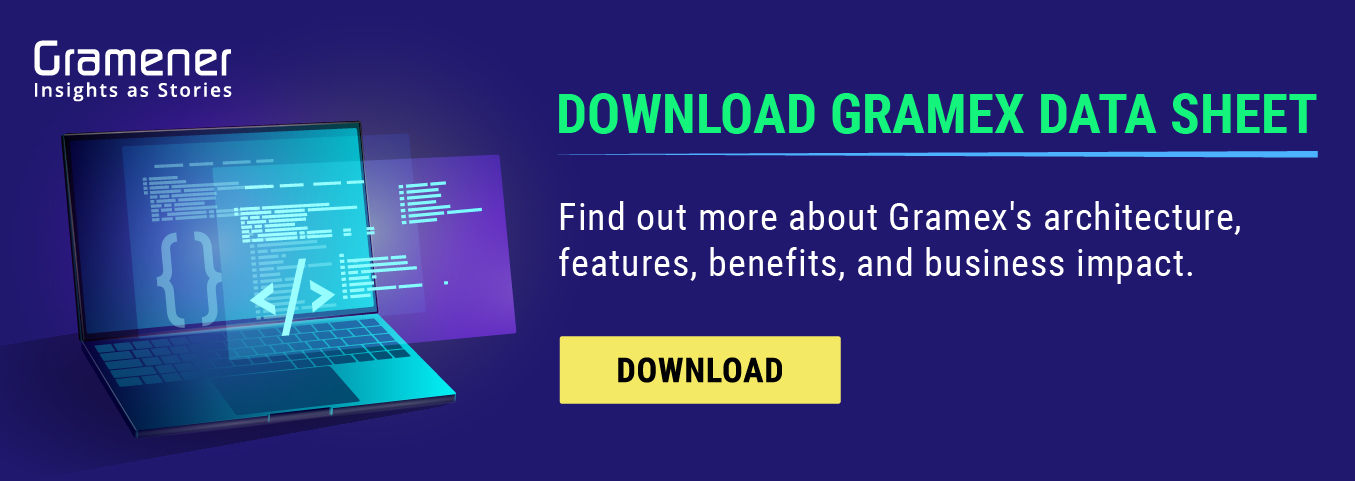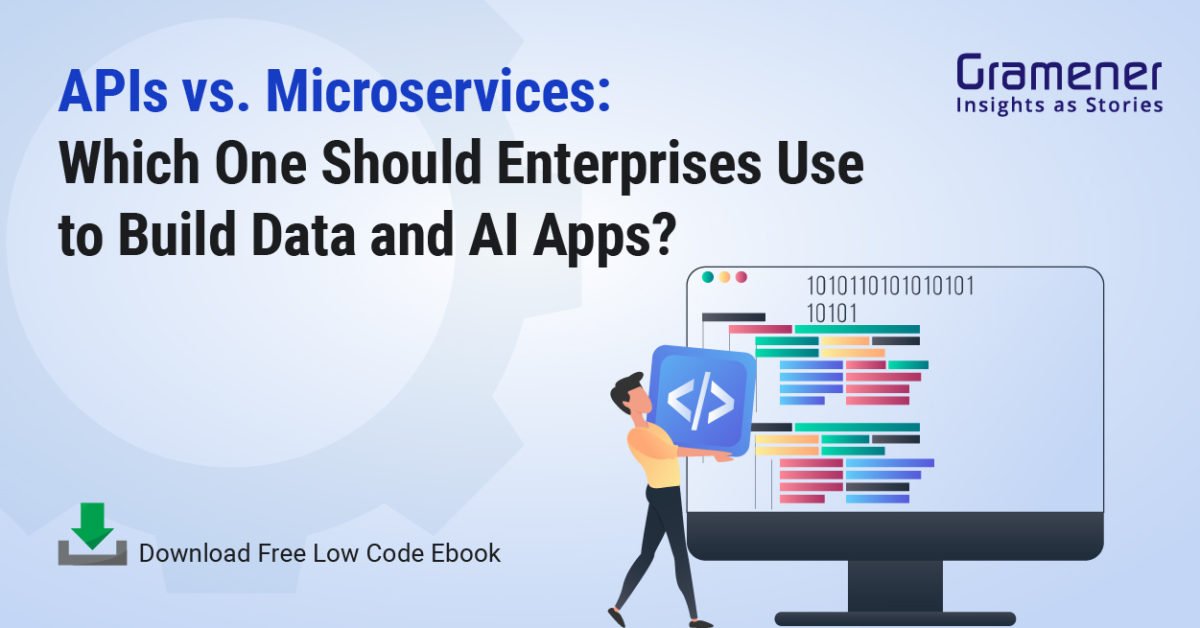If you are someone from the web applications development field, there are good chances you must have come across the terms ‘APIs’ and ‘microservice’. Debates on APIs vs Microservices, when it comes to adapting technology for creating web applications, has also been a point of concern for enteprises.
With the frequency of their usage, it can be common to assume that they are interchangeable. But that is not the case. They might have some similarities but are different from each other. In this article, we explore the differences between APIs and Microservices and how they aid in developing data and AI applications. We additionally take a look at which of the technology is suitable for web app development.
DOWNLOAD FREE LOW CODE E-BOOK
Find Out Latest Trends, Benefits & Use Cases of Low-code Development
Table of Contents
What are Microservices?
Microservices offer an architectural approach to application development, where software consists of a set of small, self-deployable services. While independent, these microservices work together.
How Microservices Work?
Microservices get delivered with the help of APIs. They are an extension of the idea that a company offers one large service. Microservices instead come across as single functions.
To simplify it and further elaborate on the use of APIs and Microservices, let’s take an example of Microsoft Excel. The different functions like count and sum, cell references, and date and time can all be microservices.
With simplicity as their prime goal, microservices help in simplifying big and complex services. A single microservice will only do the job that it got assigned to do. It will not interfere with other jobs or functions.
Another effective microservices example is a car-hailing application like Uber. The microservices here communicate through APIs and deliver different results. The user interface for passengers, notifications, trip management, and billing are all examples of microservices.
The Rise of Microservices
The concept of monolith architecture has existed right since the beginning of software development. It continues in the environments of big enterprises. Monoliths hold a range of functionalities and act as a one-point storage option. The various components of applications lie in the same spot. It includes the data access layer, business logic layer, and much more.
The execution and building of most projects start in a monolith. It is quite an easy process. But the complexity and size of the monolith become a problem when you add functionalities to the codebase. When the monolith grows over time, there can be several disadvantages. So you might wonder what the solution is? Well, it is nothing but microservices.
In fact, brands like Netflix are using microservices to build enterprise big data applications. Here’s an example.

Netflix started transforming its monolithic architecture into microservices in 2009. This helped them overcome challenges such as scaling and service outages.
Netflix today streams approximately 250 million hours of content every day. Over 139 million subscribers are using their services in more than 190 countries. Cost reduction is one of the notable benefits that Netflix received from microservices.
Here are some advantages of a microservice over a monolith.
- It is easy to separate concerns with microservices. You only need to deal with a single microservice, not the entire application at once.
- Microservices can use different tech stacks when needed. You do not have to rewrite everything in a new language. With the help of a new tech stack, you can change the microservice and proceed further.
- Microservices give you the freedom to deploy services on a need basis. You can deploy the entire application in a better way.
According to a survey of microservices adoption by businesses, 92% of them experienced success.
What is an API?
An Application Programming Interface (API) helps developers interact with an application. Users can communicate with the host through an IP address. APIs have existed ever since computing was there. It helped computers calling repeat functions that helped reduce application bloat.
How Do APIs Work in the Present Scenario?
The modern-day APIs in the digital economy are helping ease B2B communication. APIs help developers access the data and functionality of an application. It is on this principle that the applications and web pages link up to communicate and provide information.
When we talk of mobile phone applications, they connect to the Internet and send data to servers. The server will process the data and share information back with you on the phone. Applications infer the data and present it to you in a manner you can understand.
Let us consider the example of mobile banking through related apps. The banking system is the mechanism that will take your request and share the information with you. The features and functions that are available on the app act as the communicators of information. It is nothing but API.
The features will take your request and tell the system to make the information available. Within a matter of seconds, information like deposit/withdrawal history will become available to you.
APIs vs Microservices: The Differences
Here are some major differences to explore in the APIs vs Microservices debate.
- Microservices are components, whereas APIs are interfaces.
- You can use microservices to expose one or more APIs. On the other hand, API is a means to expose microservices architecture.
- Microservices are small, while APIs are large in size.
- You can build microservices much faster than APIs.
- Microservices offer simple and discrete connections of building blocks. APIs are highly formatted.
Benefits of Microservices Over APIs
- Better scalability
- Supports citizen development
- Improved fault isolation for the development of robust apps
- Enhanced data security and compliance
- Programming language and technology agnostic
- Improved deployment time and future-proofing
- Two-pizza development team support
- Better business agility and support for DevOps
How APIs and Microservices Work Together to Build Data Apps
In the APIs vs microservices debate, the value of an internal API economy increases significantly with a microservices architecture. Microservices generate more endpoints, so it becomes tough to control connectivity. When we talk of microservices architecture, which has a highly distributed environment, having an API strategy is essential.
API-led integration approach is a better way of using reusable APIs and exposing different services that need composing. It helps businesses adopt microservices better, especially when they have legacy IT stacks. All the services can get integrated easily and become valuable. API aids organizations to make microservices effective in many ways. It also becomes easy to build and manage microservices with the help of APIs.
Exposing the functionality of microservices as products leads to a better business value. Standard APIs also overcome the costs in creating integrations between legacy systems and applications. Businesses get the flexibility to add or remove a microservice based on the needs. They do not have to do much coding.
Businesses can also get standardized mechanisms for benefits like management and monitoring of traffic, security, audit, and much more. APIs also help in making microservices discoverable and reusable. The API interface aids the discoverability part. It also becomes possible to manage microservices as reusable capability.
Leading brands like Amazon, Coca-Cola, and Spotify are already using APIs and Microservices to streamline operations and create agile businesses. Unilever has more than 80 microservices to create e-commerce apps with legacy systems. The combination of microservices and API helps reduce the development and deployment time by much.
How to Build Data and AI apps With Microservices
The microservices architecture simplifies software development but can be complex to maintain. However, Low-code development platforms like Gramex have emerged as a way to knock out the complexities that come with microservices.
It uses over 200 pre-built components, libraries, apps, and single-click microservices, to create a user-friendly interface with a drag-and-drop visual approach to software development. Its UI-driven configuration lets you build data and AI apps without learning how to code. This means even citizen developers can use it to build applications rapidly and cost-effectively.
Contact us to know more about Gramex and how you can deploy it in your organization to rapidly build custom data applications.

